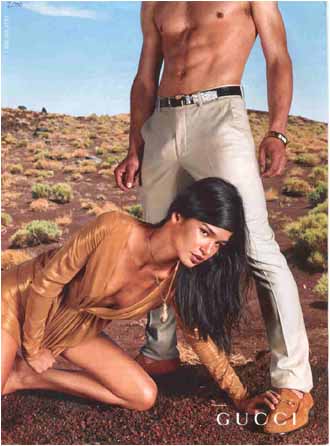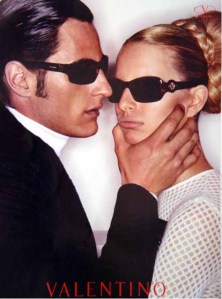A woman is an object. That’s what
we’ve been told since the dawn of time. We were made for the man. Even biblical
stores explain how Adam came first and then Eve was created for him. John
Berger in his piece Ways of Seeing says, “To be born a woman has been to be born,
within an allotted and confined space, into the keeping of men” (Berger 46).
This object is belongs to men; this object is small. These two concepts of
being made for men and being small, in a confined space, provides the basis of
what the advertising industry perpetuates through sex, beauty, and power.
In Anthony Cortese’s article, Constructing Bodies, Deconstructing Sexism
there is an ad with the caption “Quit using our cans to sell yours” (Cortese
50). This is an anti-ad but the necessity of it shows how much the advertising
industry uses sex to sell goods- even beverages. We still see this everywhere,
even in the video game industry. Grand Theft Auto, for example, is not geared
to female consumers – it is geared to male gamers and therefore they place a
very sexy female avatar on the cover of the game. Sex is used to sell anything
and everything. Business Insider tells us thirty brands that use sex to sell.
The first few are obvious from the billboards all over New York City. Just walk
into Hollister during the warmer days and you’ll see this concept very clearly:
males with muscles and abs standing out front, models inside just saying hello,
dimmed lights to create a romantic mood except we can’t actually see how the
clothes look, make a purchase and you’ll get a wonderful bag with a sexual
image and not much clothes involved. And clothes isn’t the only thing sex
sells:
In Sex, Lies and Advertising, Estee
Lauder says their products are for “a kept-women mentality” (Steinmen 119).
This concept of a “kept-women” basically refers to a women who cares about her
body not necessarily in a health-conscious way, more about aesthetically
pleasing to society. This society is of course the man's society. Her “beauty” should be “natural” and as Kilbourne says in Beauty and the Beast of
Advertising, “beauty is something that comes from without” (Kilbourne
122). Women are told they are ugly and
need to be beautiful. Their artificial beauty is to appeal to the man and once
again she is an object to place a mask upon.
A very “natural” mask that comes with a glow. However, beauty does not
simply stop at the face. Kilbourne in The More You Subtract The More You Add: Cutting Girls Down to Size, discusses how normal physiological changes during
adolescence result in increased body fat for women but these changes are
considered undesirable by the culture. She says, “Imagine, girls made to feel
so terrible about themselves that they would rather be dead than fat”
(Kilbourne 134). Magazines always tell women to love their body, but make sure
to constantly diet and excersize. “Eating for women were a priveledge”
(Kilbourne 136). Even food ads promote the notion that women should be skinny.
Power, or rather, male-power, is
used in advertising in the most subtle of ways and most obnoxious of ways. Many
advertisements use male dominance to sell even women products. Bell Hooks says
that the women’s role is “to serve, to be weak” (Hooks 18). Naomi Wolf in
her book Culture says, “Women are
mere “beauties” in men’s culture so that the culture can be kept male” (Wolf
59). We see this in the following advertisements:
A women is an object. “Women are allowed a mind or a body
but not both” (Wolf 59)
The pop culture is not reflected by
these advertisements – they are just there to show us what pop culture is
supposed to be like. They tell us that we should be beautiful and flawless and
prance into a bar full of masculine guys who will charm us with their power and
authority. In reality, it’s just a Friday night where guys in washed out
t-shirts stand outside a club catcalling women or inside watching a football
game and women with five inch heels are just trying to have a good time with
girl friends or scoring a one-night-stand.
We don’t need to promote women in
negative or subservient light, nor do we need to promote sex to sell clothes.
Make ads focused on typography and abstract art design. Make holistic ads that
promote family life. Beer ads don’t need women, they can just show a group of
men playing poker and drinking beer, good old ‘guy time’. Or a scene from How I
Met Your Mother of the friends at a bar making jokes about each other (of
course, not have all of the actors white). Make beauty ads that promote “Girls
Just Want To Have Fun” and feeling like a temporary princess, not flawlessness.
And definitely not have stick-skinny girls – spread some variety, have plus
size models, and medium-sized models, and show some flabs here and there.
Society feels uncomfortable to see a girl with a few small rolls on her belly
but if all the magazines showed it enough times, maybe things would change.
Works Cited:
“Ways
of Seeing”- John Berger
"The More
You Subtract The More You Add: Cutting Girls Down to Size" - Jean
Kilbourne
“Patriarchy” -
Bell Hooks
“Constructed Bodies, Deconstructing Ads Sexism in Advertising” - Anthony Cortese
“Sex Lies and Advertising” - Gloria Steinem Ms. Magazine
“Beauty and the Beast of Advertising” - Jean Kilbourne
“The Beauty Myth, Culture” – Naomi Wolf




No comments:
Post a Comment